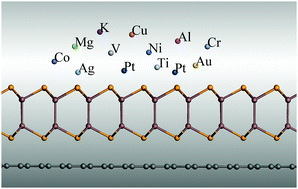Effects of graphene/BN encapsulation, surface functionalization and molecular adsorption on the electronic properties of layered InSe: a first-principles study
Abstract
By using first-principles calculations, we investigated the effects of graphene/boron nitride (BN) encapsulation, and surface functionalization by metallic elements (K, Al, Mg and typical transition metals) and molecules (tetracyanoquinodimethane (TCNQ) and tetracyanoethylene (TCNE)) on the electronic properties of layered indium selenide (InSe). It was found that an opposite trend of charge transfer is possible for graphene (donor) and BN (acceptor), which is dramatically different from phosphorene where both graphene and BN play the same role (donor). For an InSe/BN heterostructure, a change of the interlayer distance due to out-of-plane compression can effectively modulate the band gap. Strong acceptor abilities to InSe were found for the TCNE and TCNQ molecules. For K, Al and Mg-doped monolayer InSe, charge transfer from the K and Al atoms to the InSe surface was observed, causing an n-type conduction of InSe, while p-type conduction of InSe was observed in the case of Mg-doping. The atomically thin structure of InSe enables the possible observation and utilization of the dopant-induced vertical electric field across the interface. A proper adoption of the n- or p-type dopants allows for the modulation of the work function, the Fermi level pinning, the band bending, and the photo-adsorbing efficiency near the InSe surface/interface. Investigation of the adsorption of transition metal atoms on InSe showed that Ti-, V-, Cr-, Mn-, and Co-adsorbed InSe are spin-polarized, while Ni-, Cu-, Pd-, Ag- and Au-adsorbed InSe are non-spin-polarized. Our results shed light on the possible ways to protect InSe structures and modulate their electronic properties for nanoelectronics and electrochemical device applications.



 Please wait while we load your content...
Please wait while we load your content...